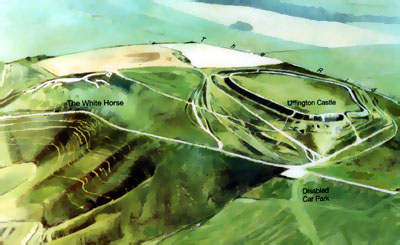
RBH Home
Maps & Travels
Articles
Legends
Towns & Villages
Castles & Houses
Churches
Biographies
Gentry
Family History
Odds & Ends
Mail David
 Uffington Castle
Uffington CastleHillfort that defies the Ages
Uffington Castle sits on the very top of White Horse Hill, just to the south of the White Horse itself. Despite its obvious categorisation as an ‘Iron Age Hillfort,’ recent excavations have shown that, like the horse and nearby settlements on Ram’s Hill (Uffington) and Tower Hill (Ashbury), it was originally constructed in the late Bronze Age, probably in the eighth or seventh century bc. The fort, at this time, consisted of early ramparts with massive timber gates and an associated linear ditch, possibly connected to Hardwell Camp, Wayland’s Smithy or a low banked ‘pre-hillfort enclosure,’ as found at other ‘Iron Age’ forts in Southern England. There was little evidence, however, for internal Bronze Age occupation.
The Uffington Castle we recognise today is an eight-acre double walled hillfort which once had timber box-ramparts that were revetted with sarsen stones at a later period. There is a north-west facing entrance, protected by the curving outwards of the bank along both sides and around the ditch. The site was occupied throughout the early to middle Iron Age period, probably at a level similar to most other excavated hillforts. Post-holes indicate not fully recognised structures and an unusal clay-lined gully may show evidence of water management. Excavated pits have shown much evidence of weaving, spinning, the keeping of animals and other activities. Coins of the Dobunni tribe have also been found in the vicinity. However, the Vale of the White Horse seems to have been an uninhabited divide between the tribes of the Dobunni and the Atrebates and Uffington Castle, with its White Horse, falls within territory of the latter, to the south of the River Ock. Permanent occupation seems to have ceased around the third to second century bc.
The hillfort then remained unoccupied for several hundred years, even though extensive Romano-British field systems on the Berkshire Downs and a number of villas in the Vale indicate that domestic life continued nearby. In the late Roman period, however, around the third century AD, evidence for considerable activity on the site reappears. An enclosure, possibly with ritual shafts, was constructed to the west of the fort and secondary burials were inserted into the adjoining Neolithic long barrow. Within Uffington Castle itself, large amounts of pottery, animal bones and low denomination coins from this period have been excavated, as well as a small bread oven. It is suggested that such remains represent the rubbish left behind after religious celebrations, not unlike those which subsequently occurred during the regular ‘Scouring of the White Horse’. There could have been an, as yet unlocated, temple remaining within the hillfort throughout Roman times, as at Maiden Castle (Dorset) and other hillforts in the South of England; or perhaps nearby Dragon Hill was an open–air sanctuary. Newly created breaks in the ramparts, particularly that on the noerthen side, certainly allowed better access to the small knoll and the great hill-figure.
